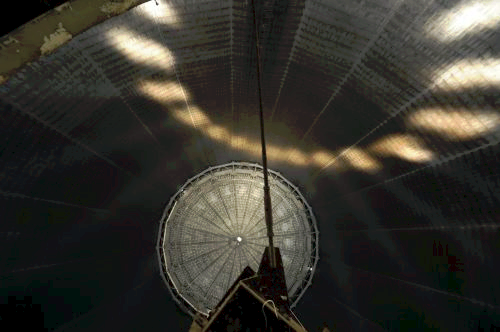
Organ pipes generate sound by inducing resonance in the column of air inside the pipe. These oscillations then propagate into the surrounding air. In the case of the gasometer the volume of about 100,000 cubic meters inside the huge metal cylinder acts as another resonator coupled to the pipes' oscillating airflow. As the pipes are distributed throughout the space, this brings about a rich, constantly evolving soundscape inside the building which is unlike anything you could produce with loudspeakers.
The pipes were chosen to be of the "Principal" type, sounding rather flute-like at their fundamental frequency. As the acoustics of the gasometer show extremely long reverb (around 16 seconds), various distinct echos on the walls and the ceiling as well as diffuse reflections on the inner structures, the soundscape has amazing harmonics generated by the interference of the various sound sources.
Incidentally, the reverberation time is very close to the pendulum's period. Therefore, the tempo of the music, the visible beat of the metronome and the dynamics of the soundfield which can be physically sensed match perfectly. The so-called "speech" of the pipes accentuates the addition of new notes, the reverb lets the sounds evolve, the resonance makes the notes melt into harmonies.
The pipes were chosen to be of the "Principal" type, sounding rather flute-like at their fundamental frequency. As the acoustics of the gasometer show extremely long reverb (around 16 seconds), various distinct echos on the walls and the ceiling as well as diffuse reflections on the inner structures, the soundscape has amazing harmonics generated by the interference of the various sound sources.
Incidentally, the reverberation time is very close to the pendulum's period. Therefore, the tempo of the music, the visible beat of the metronome and the dynamics of the soundfield which can be physically sensed match perfectly. The so-called "speech" of the pipes accentuates the addition of new notes, the reverb lets the sounds evolve, the resonance makes the notes melt into harmonies.

The acoustics of the gasometer surprised us while tuning the organ pipes. As the pronounced resonance effects apply all over the frequency range, pure major chords don't sound well-tuned at all when "tempered" scales are used, which are the norm for modern instruments like the piano.
In the end, we settled for a diatonic C-Major scale. As higher harmonics (and even sub-harmonics) amplify each other strongly inside the gasometer, the contrast between pure major chords and strained or dissonant chords used in Bach's ingenious modulations becomes a bodily experience.
Bach's prelude (BWV 846) is part of the famous pieces for "the well-tempered piano". Paradoxically, we had to resort to ancient natural scales to do justice to the composer's rather modern concept.
In the end, we settled for a diatonic C-Major scale. As higher harmonics (and even sub-harmonics) amplify each other strongly inside the gasometer, the contrast between pure major chords and strained or dissonant chords used in Bach's ingenious modulations becomes a bodily experience.
Bach's prelude (BWV 846) is part of the famous pieces for "the well-tempered piano". Paradoxically, we had to resort to ancient natural scales to do justice to the composer's rather modern concept.
